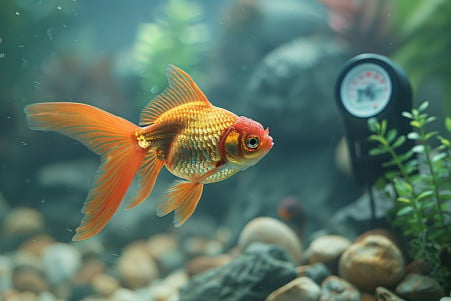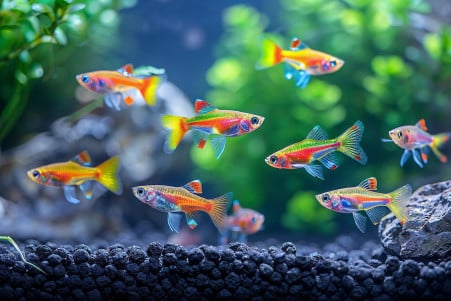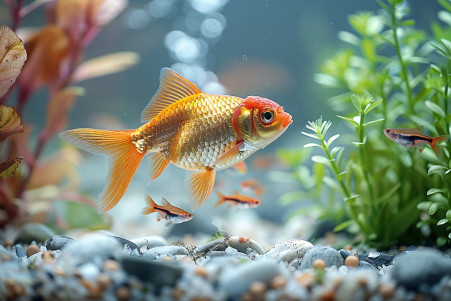Do Guppies Need a Heater? Their Ideal Temperature Range
22 March 2024 • Updated 22 March 2024

Since guppies are tropical freshwater fish, it's not surprising that many people who keep them in an aquarium wonder if they need a heater. The short answer is that guppies prefer their water to be between 72-82°F, so unless you live in a climate where you can maintain that temperature in your tank without a heater, you'll want to use one to keep your guppies comfortable and healthy in their tropical environment.
To determine if guppies actually need a heater, let's take a look at the biological evidence that has been published on the temperature tolerance and preferences of guppies, as well as the conditions that are best for their growth and reproduction. This will help you better understand what guppies need to be healthy and happy based on their natural habitat and biological requirements.
Do Guppies Need a Heater?
Monitoring Water Quality to Keep Guppies Healthy
In addition to temperature, guppies need certain water conditions to stay healthy. Per Aquarium Co-Op, guppies prefer a pH of 6.8-7.8, which is similar to the slightly brackish water they live in in the wild, but 7.0 is the best pH level. Ammonia and nitrites need to be at 0 ppm, and nitrates should be below 20 ppm, which can be maintained through regular water changes.
Guppies also like water that is moderately hard, which means it should be between 150-200 ppm, as noted by Aquaholics. It's important to keep these levels consistent, and that means regular tank maintenance, including weekly water changes, making sure you have a good filter, and not overstocking your tank.
Via Light.fish, some of the best pH test kits include the Hanna Instruments HI38058 or API kits, which can help you make sure that your tank's pH is where it needs to be. By keeping these levels in the right zones, and making sure that the water is warm, you can make sure that your guppies are in the best possible position to thrive.
Guppy Tank Setup and Environmental Enrichment
Guppies need at least a 10-gallon tank for a small group, says Aquarium Co-Op. Live plants, driftwood, and rocks will offer hiding places and environmental enrichment that will help replicate their natural tropical environment. Steinsworth suggests keeping the water flow low and the lighting moderate, since guppies are used to slower-moving water.
Making sure that there is plenty of room for swimming and that the tank isn't overcrowded is also important for keeping stress levels down, according to AquariumStoreDepot. When choosing tank mates, look for other peaceful community fish that can live in the same water conditions as guppies. This will ensure that your guppy tank is a happy, stress-free place for your colorful fish.
How to Choose the Right Guppy Tank Mates
Guppies are peaceful community fish that can be kept with other non-aggressive fish. AquariumStoreDepot lists corydoras catfish, otocinclus, mollies, swordtails, tetras, rasboras, and some small plecos as good examples of guppy tank mates. These fish are similar in size to guppies and have similar water parameter needs.
On the other hand, FishLab warns that guppies should not be kept with large or aggressive fish, such as cichlids and large gouramis, that may bully or even eat them. To avoid territorial aggression between fish, make sure that your tank has plenty of hiding places and open swimming areas. PetMojo also notes that it’s important to make sure that your guppies’ tank mates have similar water parameter needs to ensure that they are healthy and happy.
If you choose other peaceful community fish that have similar needs, you can make sure that your guppies live in a happy and healthy tank.
Common Diseases and Treatment of Guppies
Guppies are susceptible to a number of bacterial, parasitic, and fungal diseases if water quality is not maintained. Guppy Aquarium lists some of the most common guppy diseases as ich (white spot disease), fin rot, dropsy, velvet, and gill flukes.
Symptoms can include white spots, tattered fins, bloating, erratic swimming, and breathing problems. Tiny Little Paws explains that ich is caused by a parasitic protozoan and can be treated by isolating the infected fish, increasing the water temperature, and using medications. Fin rot, which is a bacterial disease, can be avoided and treated by keeping the water clean and using antibacterial medications.
JapaneseFightingFish.org explains that other common guppy diseases like dropsy, velvet, and gill flukes need to be diagnosed and treated quickly and are usually treated with specific medications. Regularly cleaning the tank, quarantining new fish, and keeping the fish from getting stressed are the most important ways to keep diseases from happening in the first place.
Knowing the common diseases of guppies and how to treat them can help aquarists make sure they are doing everything they can to keep their tropical fish healthy and happy.
How to Breed Guppies and Take Care of Guppy Fry
Guppies are livebearers, which means they give birth to live young. They can have up to 40 babies at a time. Tropical Fish Hobbyist Magazine notes that the typical number of fry in a guppy litter is between 20 and 40, but larger females can have even more. Female guppies can have multiple litters in a row without mating because they can store sperm.
To breed guppies, wikiHow suggests setting up a separate breeding tank and adding one male and one female guppy. Once the guppies have mated, the male should be removed from the tank to prevent stress and infanticide. The breeding tank should be set up with lots of hiding places, gentle filtration, and a water temperature between 78 and 80°F.
wikiHow Pet recommends feeding the baby guppies a few times a day with nutritious foods like crushed dry food, bloodworms, brine shrimp, and daphnia. It's also important to change part of the water in the tank regularly as the fry grow to make sure the water stays clean and healthy for them.
Conclusion: How to Create the Best Environment for Guppies
Guppies are hardy fish, but they need specific environmental conditions to thrive. In addition to keeping the water temperature in the range of 72-82°F with a heater, stable water parameters, proper tank setup, and compatible tank mates are all important for guppy health. Preventative care, including quarantining, maintaining water quality, and reducing stress, can help prevent diseases.
It's also important to choose peaceful community fish as tank mates. Guppies are happiest when they are kept with other fish that are compatible with their needs and can tolerate the same water conditions. By ensuring that these needs are met, you can help your guppies live their best lives in your aquarium.


